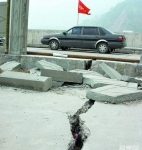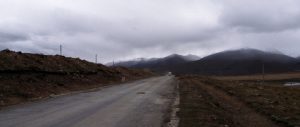The Chinese government’s recently disclosed 4-trillion-yuan (US$585 billion) economic stimulus package has revived interest in hydropower projects in the country’s southwest. Yunnan province and Sichuan province have accelerated work on projects that were already planned or under construction. On a recent reporting trip to Yunnan, I saw that in some cases this has meant building work starting before any kind of environmental impact assessment (EIA) has been conducted.
At the Guanyinyan dam, in Huaping county, and Ludila dam, in Bingchuan county, construction vehicles speed back and forth amid clouds of dust. EIAs have not been undertaken for either of these dams. Even elementary safety checks have not been performed and government regulators are absent. The hydropower authorities claim that the activity is part of preparatory work for feasibility studies, but actual construction work – the building of roads, spillways and abutments – is underway. Waste material from the work is being dumped directly into the Jinsha River and the increase in silt is damaging the hot-arid valley ecosystem. More critically, the dam’s reservoir lies over the Chenghai fault and near unstable mountain slopes that are vulnerable to landslides, mudslides and earthquakes. In August 2008, a mudslide near the Ludila dam killed eight people. EIAs are clearly essential when constructing dams in an area this prone to geological incidents.
At the site of the Ahai dam, in Yongsheng county, the construction I witnessed on an earlier visit in April last year was not visible, but the project was still going ahead without official approval. Construction subsidiaries of the Sinohydro Corporation started preliminary work three years ago, completing roads, spillways and abutments. On my recent trip I found that the environment authorities were still planning to visit and decide if they would approve the project. But they will be presented with a dam that is as good as built. The lack of an EIA meant the project was illegal, so work was carried out in secret. Signs declaring the site a “military zone” were erected to discourage visitors. Meanwhile, the company behind the dam project at Jin’anqiao, in Yulong county, have not bothered with an EIA at all: spillways, abutments and the dam itself are all finished and generators are being installed for testing.
A plan for a string of eight dams along Tiger Leaping Gorge was one of the first hydropower projects to attract media attention, and the scheme was abandoned as a result. However, new economic circumstances have led to the project being relaunched upriver under another name: the Longpan dam. The project is essentially the same, and exploratory drilling and infrastructure construction are now taking place. If a dam is built at Longpan, 100,000 people living by the Jinsha River will be forced to relocate and 200,000 mu of farmland (133 square kilometres) will be inundated. This will mean the 40-billion-yuan (US$5.9 billion) project will also have a direct impact on the central government’s pledge to maintain a minimum of 1.8 billion mu (1. 2 million square kilometres)of arable land. The results of the EIA for this project are forthcoming.
At the site of the Saige dam on the Nu River, I saw work on tunnels and construction campsites taking place. The tributaries of the Nu River have been divided up among contractors for preparatory construction work. Despite the lack of an EIA, work has been underway for the last few years. No other project is as controversial as the Nu River: issues of biodiversity, soil loss, geological dangers, displacement and cultural heritage have all received media attention. However, journalists and the public face an uphill struggle as they struggle to protect China’s last major undeveloped river. The Yabiluo dam is planned only 5.5 kilometres from a UNESCO World Heritage site, with its reservoir extending to less than three kilometres away. The Maji reservoir is even closer: the dam itself will be just over two kilometres from a World Heritage site, with the waters of the reservoir 810 metres away. When faced with a choice between heritage preservation and hydropower projects, local governments will always find an excuse to opt for the latter.
Soil, vegetation and rivers will suffer worst from these hydropower developments, as will generations of ethnic minority peoples – Yi, Lisu, Nu, Pumi, Naxi and Tibetans – who live in the region. They are willing to sacrifice their interests for the sake of the nation and want only to be able to survive. The homes and living conditions of the Naxi people in the town of Shigu, in Lijiang – a major crossing point the during the Long March – and Chezhou village, in Shangri-La county, show that they became better-off than many others in China. However, hydropower projects may throw them back into poverty. The majority of locals are unwilling to move. If the project will benefit both the nation and the people, they ask, then why not carry out a public EIA?
Hydropower developments incur massive social and environmental costs. Reservoirs inundate huge areas of farmland and ecosystems, and construction dumps large amounts of dirt into rivers, harming irrigation works downstream. The relocation of residents puts pressure on land resources, while inundated fields release methane – a powerful greenhouse gas – into the atmosphere. Even if we ignore “soft” factors such as the impact on heritage, culture and scenery, hydroelectricity is by no means “clean” power. But in Yunnan province it seems nothing can stand in the way of these projects. EIAs have become a marginalised and decorative process, seen as just a part of the cost of doing business. Both the builders and local government know that, to date, an EIA has never managed to halt a dam project.
We can ruin all of China’s river ecosystems for the sake of profit, but we will find that the money we earn cannot offset what we have lost. Hydropower projects in southwest China need a proper cost-benefit analysis in order to ensure rational development, with full consideration of the impact of constructing and removing dams. The cost to water and land ecosystems, biodiversity, society and cultures needs to be taken into account along with the geological dangers. If the scientific view of development [pdf] were used to guide economic growth, EIAs for hydropower projects would no longer be mere decorations.
Jiang Gaoming is a professor at the Chinese Academy of Sciences’ Institute of Botany. He is also vice secretary-general of the UNESCO China-MAB (Man and the Biosphere) Committee and a member of the UNESCO MAB Urban Group.
Homepage photo by My Hobo Soul



